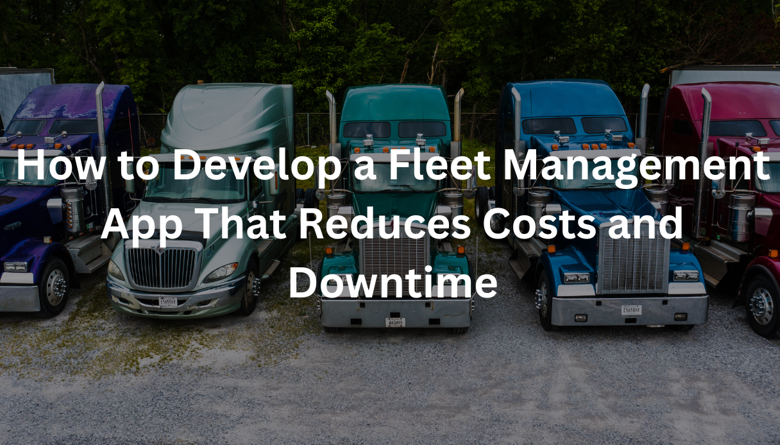How to Develop a Fleet Management App That Reduces Costs and Downtime

In today’s fast-paced logistics and transportation industry, efficiency is everything. Businesses rely heavily on vehicles for deliveries, services, and operations, which makes fleet management an essential part of daily workflow. However, managing large fleets manually often leads to inefficiencies — from delayed maintenance to fuel wastage and unplanned downtime.
That’s where fleet management apps come in. These smart digital tools give businesses complete visibility over their vehicles, drivers, routes, and maintenance schedules, enabling cost reduction and productivity enhancement.
In this guide, we’ll walk through how to develop a fleet management app that minimizes costs and downtime, while delivering long-term value to your business.
1. Understanding the Role of a Fleet Management App
A fleet management app is a digital platform that helps businesses monitor, manage, and optimize their vehicle operations. It connects vehicles, drivers, and administrators through IoT devices and GPS tracking systems.
These apps do more than track location — they collect real-time data about driver behavior, fuel consumption, engine health, and maintenance schedules. Managers can use this data to make informed decisions, prevent issues before they arise, and boost overall fleet efficiency.
Key benefits include:
- Reduced fuel and maintenance costs
- Improved vehicle uptime
- Real-time visibility and alerts
- Enhanced driver performance
- Streamlined compliance and documentation
When done right, a fleet management app can help businesses save thousands of dollars each year while ensuring smoother operations.
2. Core Features That Minimize Costs and Downtime
Developing an efficient fleet management app requires more than basic tracking functionality. You need advanced tools that directly address cost drivers and downtime causes. Here are the essential features to include:
a. Real-Time Vehicle Tracking
GPS-based tracking allows managers to monitor each vehicle’s movement in real time. You can optimize routes, reduce unnecessary idling, and identify delays instantly. This helps cut fuel expenses and ensures timely deliveries.
b. Predictive Maintenance
Downtime is one of the biggest hidden costs in fleet management. Predictive maintenance uses sensor data and analytics to detect early signs of mechanical issues before they become costly breakdowns. The app can send automatic alerts for oil changes, tire rotations, or part replacements based on mileage or performance trends.
c. Fuel Management
Fuel is often the largest operational expense for fleet-based companies. A fuel management system tracks fuel usage, idling time, and refueling patterns. This helps detect inefficiencies or misuse, ultimately reducing fuel-related expenses.
d. Driver Behavior Monitoring
Monitoring how drivers handle vehicles can significantly impact costs and safety. Features like speed tracking, harsh braking alerts, and fatigue monitoring promote responsible driving. Better driving habits reduce accident risks and maintenance costs.
e. Route Optimization
Using AI-powered algorithms, your app can suggest the most efficient routes considering traffic, weather, and distance. This feature helps shorten delivery times, reduce fuel consumption, and improve overall productivity.
f. Automated Reporting and Analytics
A dashboard with detailed analytics helps managers visualize performance metrics — vehicle utilization, downtime trends, and operational efficiency. With actionable insights, they can make smarter decisions to lower expenses and enhance productivity.
g. Integration with IoT and Telematics
Integrating IoT sensors, telematics devices, and diagnostic tools allows for continuous data collection on vehicle health. This real-time information can trigger maintenance alerts or performance notifications automatically.
3. Planning Your Fleet Management App
Before diving into development, it’s crucial to define your objectives clearly. Ask questions like:
- What size of fleet will the app manage?
- What specific challenges do you want to solve — maintenance, routing, driver performance, or compliance?
- Which platforms (Android, iOS, Web) will you support?
Once the scope is defined, focus on the user experience (UX). The interface should be intuitive for both drivers and fleet managers. Complex systems often lead to poor adoption, defeating the purpose of digital transformation.
Also, consider the app’s scalability. As your fleet grows, the app should be capable of handling more data, vehicles, and integrations without performance issues.
4. Choosing the Right Tech Stack
Selecting the right technology stack is vital for performance, security, and scalability. Here’s a general idea of what you might need:
- Frontend: React Native or Flutter (for cross-platform mobile apps)
- Backend: Node.js, Python, or Java
- Database: PostgreSQL, MongoDB, or Firebase
- Cloud Infrastructure: AWS, Google Cloud, or Microsoft Azure
- APIs and Integrations: Google Maps API, OpenStreetMap, IoT device APIs
Security is also a top priority. Ensure that all data — from location tracking to maintenance logs — is encrypted and stored safely. Implement role-based access control (RBAC) so only authorized users can access sensitive information.
5. Development Process
Building a successful fleet management app follows a structured process:
See also: The Power of Data-Driven Decision Making in Modern Business
Step 1: Research and Requirement Analysis
Study your target users — fleet owners, drivers, and logistics teams. Identify their major pain points to ensure your app offers real solutions.
Step 2: UI/UX Design
Design wireframes and prototypes focusing on usability. A clean, easy-to-navigate interface encourages better adoption by end users.
Step 3: MVP Development
Start with a Minimum Viable Product (MVP) that includes core features like real-time tracking, route optimization, and maintenance alerts. Launch it to a small audience and gather feedback.
Step 4: Testing and Quality Assurance
Perform thorough testing to ensure the app works smoothly across all devices. Pay special attention to GPS accuracy, data syncing, and system performance under load.
Step 5: Deployment and Maintenance
After successful testing, deploy the app on your chosen platforms. Post-launch, monitor app performance, fix bugs, and add features based on user feedback. Continuous updates help maintain app reliability and performance.
6. Cost Considerations
The cost of developing a fleet management app depends on several factors — app complexity, number of features, technology stack, and developer expertise.
- Basic app: $15,000 – $30,000
- Mid-level app: $30,000 – $60,000
- Advanced app with IoT integration: $60,000+
Outsourcing development to a Fleet Management Software Development Company is often the most cost-effective option. They bring expertise, ready-made frameworks, and industry experience that accelerate development and reduce technical risks.
7. How the App Reduces Costs and Downtime
A well-designed fleet management app delivers measurable savings in multiple ways:
- Proactive Maintenance: Prevents costly breakdowns.
- Fuel Efficiency: Tracks and optimizes consumption.
- Optimized Routing: Reduces travel time and distance.
- Driver Accountability: Improves safety and lowers repair costs.
- Data Insights: Helps managers make smarter operational decisions.
Over time, these optimizations translate to higher profitability and fewer unplanned interruptions.
8. Future Trends in Fleet Management Apps
The future of fleet management is deeply tied to emerging technologies. Features like AI-based predictive analytics, blockchain-based maintenance records, and autonomous vehicle integration will soon redefine the landscape.
Moreover, sustainability is gaining attention. Apps that monitor carbon emissions and promote eco-friendly driving practices will be increasingly valuable to businesses committed to green logistics.
Conclusion
Developing a fleet management app that reduces costs and downtime isn’t just about adding tracking features — it’s about building a complete ecosystem that connects data, devices, and decisions.
From predictive maintenance to route optimization, each feature plays a crucial role in maximizing uptime and reducing operational expenses. Collaborating with experts in custom mobile app development ensures your solution is tailored precisely to your business needs — scalable, secure, and ready for the future.
By investing in the right digital tools today, your fleet-based business can achieve higher efficiency, lower costs, and a competitive advantage in tomorrow’s transportation landscape.





